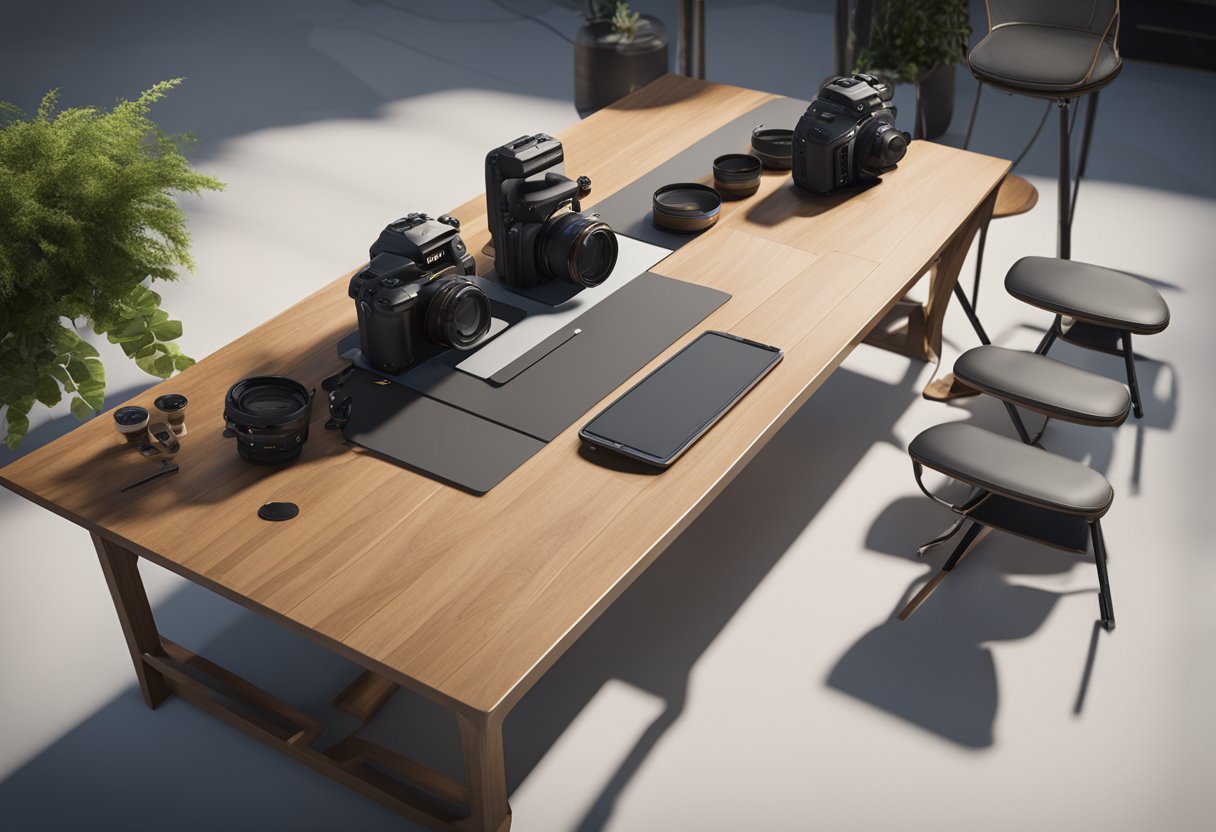Imagine this: Sarah is an aspiring vodcast creator with a passion for sharing her knowledge and experiences in the world of fashion. She spends hours meticulously planning her vodcast episodes, from the content to the visuals. She knows that the success of her vodcast relies not only on the quality of the information she provides but also on how it is presented to her audience.
One day, Sarah decides to watch a vodcast that has been highly recommended to her. As she clicks play, she is immediately greeted with a jarring camera angle that makes it difficult to focus on the host’s face. Frustrated, Sarah finds herself unable to fully immerse herself in the content that she was so excited to devour.
Camera angles may seem like a small detail, but they can greatly impact the overall experience of a vodcast. The wrong angles can distract and disconnect viewers, while the right angles can captivate and engage them. In this article, we will explore the art of choosing the best camera angles for vodcasts and how they can help you optimize your vodcast.
How to Choose Vodcast Camera Angles
When it comes to creating compelling vodcast content, choosing the right camera angles is essential. The way you frame and position the camera can greatly impact the way your message is conveyed and how engaging your vodcast is to the audience. To help you make informed decisions, here are some practical tips and considerations for selecting the most suitable camera angles for your vodcast.
- Understand your content: Before selecting camera angles, it’s crucial to have a clear understanding of the type of content you’re creating. Consider the tone, mood, and subject matter of your vodcast. Are you aiming for an intimate and personal feel or a more professional and polished look? This will guide your camera angle choices.
- Think about context: Contextualize your content by determining the purpose and message of your vodcast. Are you trying to educate, entertain, or inspire? Different camera angles can help convey these intentions. For example, a close-up shot might work well for emotional or impactful moments, while a wide shot can capture the overall atmosphere or venue.
- Experiment with different angles: Don’t be afraid to try out various camera angles to see what works best for your content. Consider filming from different heights and perspectives, such as eye-level, overhead, or ground-level shots. Each angle can provide a unique visual experience and add depth to your vodcast.
- Pay attention to framing: Framing is essential for highlighting key elements in your vodcast. Whether it’s a person, an object, or a scene, ensure that it is properly framed within the frame. Experiment with rule of thirds, leading lines, and negative space to create visually appealing compositions.
- Consider camera movement: Camera movement adds dynamism and visual interest to your vodcast. Determine whether you want static shots, smooth pans, tilts, or even tracking shots. Remember to use camera movement purposefully to enhance the storytelling and maintain audience engagement.
- Test and review: Once you’ve selected your camera angles, it’s important to test them out and review the footage. Pay attention to the overall composition, clarity, and how well the angles convey your intended message. Don’t hesitate to make adjustments and reshoot if necessary.
By following these tips and considering the unique characteristics of your vodcast, you can choose camera angles that best represent your content and effectively engage your audience. Remember, selecting the right camera angles is an art, and with practice and experimentation, you’ll be able to create visually captivating vodcast content.
Professional Vodcast Camera Shots
When it comes to creating captivating vodcast content, professional camera shots play a crucial role in enhancing the visual storytelling and engaging the audience. By strategically using different shot types, vodcast creators can create a dynamic and immersive viewing experience that keeps viewers hooked from start to finish.
Wide Shots
A wide shot, also known as an establishing shot, is used to set the scene and provide context to the viewers. It captures a large area, showcasing the entire vodcast set or location. Wide shots are perfect for introducing a new segment, revealing the setting of an interview, or highlighting the overall atmosphere of the vodcast.
Close-ups
Close-ups are tight shots that focus on a specific subject, such as a person’s face or an object. They are excellent for capturing emotions, emphasizing details, and creating a more intimate connection with the audience. Close-ups are commonly used during interviews, highlighting reactions, or showcasing important elements within the vodcast.
Over-the-Shoulder Shots
An over-the-shoulder shot provides a perspective from behind one person, typically showing their back and shoulder while focusing on the person or object they are interacting with. This shot is often used during conversations or interviews to emphasize the interaction between two individuals. Over-the-shoulder shots add depth and visual interest to the vodcast, making viewers feel like they are part of the conversation.
“Using professional camera shots in your vodcast can elevate the production value and create a more immersive experience for the viewers. It’s important to choose the right shot type based on the content and storytelling goals to effectively convey your message.”
Incorporating various professional camera shots into your vodcast can greatly enhance its visual appeal and storytelling impact. By experimenting with different shot types, angles, and compositions, vodcast creators can elevate their content to new heights and captivate their audience from start to finish. Remember, understanding the purpose and when to utilize each shot is key to creating a visually captivating vodcast.
| Shot Type | Purpose | When to Use |
|---|---|---|
| Wide Shots | Set the scene and provide context | Introduce a new segment, reveal the vodcast setting, highlight the overall atmosphere |
| Close-ups | Focus on emotions and emphasize details | Showcase reactions, highlight important elements |
| Over-the-Shoulder Shots | Emphasize interaction between individuals | During conversations or interviews |
Vodcast Camera Setup Angles
When it comes to creating captivating vodcast content, the right camera angles can make all the difference. Proper camera setup angles not only enhance the visual appeal of your vodcast but also add depth and variety to your videos. In this section, we will explore different camera positioning and placement techniques that can take your vodcast to the next level.
High and Low Angles
One effective way to add visual interest to your vodcast is by experimenting with high and low camera angles. A high angle shot can make the subject appear smaller and more vulnerable, while a low angle shot can make the subject seem larger and more powerful. These angles can be used strategically to create different moods and emphasize certain aspects of your vodcast.
Dutch Angles
If you’re looking to infuse your vodcast with a sense of unease or tension, consider incorporating dutch angles. A dutch angle is achieved by tilting the camera slightly to one side. This technique can add a dynamic and disorienting effect to your vodcast, creating an atmosphere that keeps viewers engaged and on the edge of their seats.
Multi-camera Setups
Another way to bring variety to your vodcast is by utilizing multi-camera setups. By positioning multiple cameras at different angles, you can capture various perspectives simultaneously. This allows for seamless transitions between shots, creating a more dynamic viewing experience. Multi-camera setups are particularly effective for interviews, debates, or any vodcast that involves multiple participants.
Remember, the key to using camera setup angles effectively is to align them with the content and message of your vodcast. Consider the emotions you want to evoke, the story you want to tell, and the overall atmosphere you aim to create. By carefully selecting and implementing camera setup angles, you can transform your vodcast into a visually captivating and engaging experience for your audience.
| Camera Angle | Effect |
|---|---|
| High Angle | Makes the subject appear smaller and more vulnerable |
| Low Angle | Makes the subject seem larger and more powerful |
| Dutch Angle | Creates a dynamic and disorienting effect |
| Multi-camera Setup | Allows for seamless transitions and captures different perspectives |
Enhancing Visual Appeal with Vodcast Camera Angles
Choosing the right camera angles can significantly enhance the visual appeal of your vodcast content. By utilizing the top vodcast camera angles, you can create a more immersive and engaging viewing experience for your audience.
One of the most effective camera angles to consider is the “over-the-shoulder” shot. This angle provides a glimpse of the host or participants from the perspective of another person in the conversation, creating a sense of involvement and connection. It adds depth and dimension to the footage, making viewers feel like they’re part of the discussion.
Another popular camera angle for vodcasts is the “wide shot.” This wide-angle view allows viewers to see the entire set or location, providing context and establishing the overall atmosphere. Whether you’re showcasing a studio setup or a picturesque outdoor location, the wide shot can give your vodcast a professional and polished look.
For more visually dynamic content, consider incorporating the “Dutch angle” into your vodcast. This camera technique involves tilting the camera at an angle, creating a sense of unease or tension. It’s often used to convey drama or suspense and can add a unique aesthetic to your vodcast.
To capture the emotions and nuances of your guests or hosts, close-up shots can be incredibly impactful. Zooming in on facial expressions or subtle gestures can help viewers connect on a deeper level with the individuals on screen. These close-ups can capture the essence of the moment and add an emotional touch to your vodcast.
Examples of Top Vodcast Camera Angles:
| Camera Angle | Description |
|---|---|
| Over-the-Shoulder Shot | Provides a viewpoint from another person in the conversation, adding depth and connection. |
| Wide Shot | Establishes the overall atmosphere and context by showing the entire set or location. |
| Dutch Angle | Tilts the camera at an angle, creating tension and adding an artistic touch to the footage. |
| Close-Up Shot | Zooms in on facial expressions and gestures, capturing emotions and enhancing viewer connection. |
By incorporating these top vodcast camera angles into your content, you can elevate the visual appeal and engage your audience on a whole new level. Experiment with different angles depending on the tone, subject matter, and desired impact of each segment. Remember, choosing the right camera angle is an art form that can make a significant difference in the overall success of your vodcast.
Conclusion
In conclusion, camera angles play a crucial role in optimizing vodcasts and enhancing the visual appeal of the content. By carefully selecting the right camera angles, vodcast creators can engage their audience more effectively and convey their message with greater impact.
Throughout this article, we have explored various aspects of camera angles in vodcasts, from how to choose the most suitable angles to professional camera shots and setup angles. We have highlighted the importance of considering the purpose and desired effect of each shot, as well as the role of camera placement and positioning in achieving the desired visual composition.
By utilizing top camera angles, such as wide shots, close-ups, and over-the-shoulder shots, vodcast creators can create a visually captivating and dynamic viewing experience for their audience. These camera angles, when used strategically, can enhance the overall quality of the vodcast and make it more engaging and memorable.
In conclusion, mastering the art of camera angles in vodcasts is essential for any vodcast creator who aims to produce high-quality and visually compelling content. By applying the tips and techniques discussed in this article, vodcast creators can take their productions to the next level and captivate their audience through visually captivating and engaging visual storytelling.

